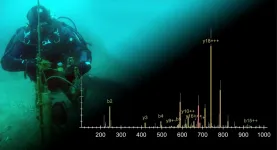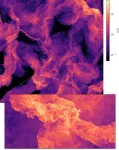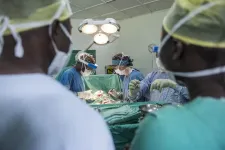Team creates hybrid chips with processors and memory to run AI on battery-powered devices
Today's electronics waste energy by using separate chips to process and store data. New algorithms enable energy-efficient hybrids to work together as one mega-chip.
2021-01-11
(Press-News.org) Smartwatches and other battery-powered electronics would be even smarter if they could run AI algorithms. But efforts to build AI-capable chips for mobile devices have so far hit a wall - the so-called "memory wall" that separates data processing and memory chips that must work together to meet the massive and continually growing computational demands imposed by AI.
"Transactions between processors and memory can consume 95 percent of the energy needed to do machine learning and AI, and that severely limits battery life," said computer scientist Subhasish Mitra, senior author of a new study published in Nature Electronics.
Now, a team that includes Stanford computer scientist Mary Wootters and electrical engineer H.-S. Philip Wong has designed a system that can run AI tasks faster, and with less energy, by harnessing eight hybrid chips, each with its own data processor built right next to its own memory storage.
This paper builds on the team's prior development of a new memory technology, called RRAM, that stores data even when power is switched off - like flash memory - only faster and more energy efficiently. Their RRAM advance enabled the Stanford researchers to develop an earlier generation of hybrid chips that worked alone. Their latest design incorporates a critical new element: algorithms that meld the eight, separate hybrid chips into one energy-efficient AI-processing engine.
"If we could have built one massive, conventional chip with all the processing and memory needed, we'd have done so, but the amount of data it takes to solve AI problems makes that a dream," Mitra said. "Instead, we trick the hybrids into thinking they're one chip, which is why we call this the Illusion System."
The researchers developed Illusion as part of the Electronics Resurgence Initiative (ERI), a $1.5 billion program sponsored by the Defense Advanced Research Projects Agency. DARPA, which helped spawn the internet more than 50 years ago, is supporting research investigating workarounds to Moore's Law, which has driven electronic advances by shrinking transistors. But transistors can't keep shrinking forever.
"To surpass the limits of conventional electronics, we'll need new hardware technologies and new ideas about how to use them," Wootters said.
The Stanford-led team built and tested its prototype with help from collaborators at the French research institute CEA-Leti and at Nanyang Technological University in Singapore. The team's eight-chip system is just the beginning. In simulations, the researchers showed how systems with 64 hybrid chips could run AI applications seven times faster than current processors, using one-seventh as much energy.
Such capabilities could one day enable Illusion Systems to become the brains of augmented and virtual reality glasses that would use deep neural networks to learn by spotting objects and people in the environment, and provide wearers with contextual information - imagine an AR/VR system to help birdwatchers identify unknown specimens.
Stanford graduate student Robert Radway, who is first author of the Nature Electronics study, said the team also developed new algorithms to recompile existing AI programs, written for today's processors, to run on the new multi-chip systems. Collaborators from Facebook helped the team test AI programs that validated their efforts. Next steps include increasing the processing and memory capabilities of individual hybrid chips and demonstrating how to mass produce them cheaply.
"The fact that our fabricated prototype is working as we expected suggests we're on the right track," said Wong, who believes Illusion Systems could be ready for marketability within three to five years.
INFORMATION:
Subhasish Mitra is a professor of electrical engineering and of computer science. Mary Wootters is an assistant professor of computer science and of electrical engineering. H.-S. Philip Wong is the Willard R. and Inez Kerr Bell Professor in the School of Engineering. Additional co-authors include graduate students Andrew Bartolo, Paul C. Jolly, Zainab F. Khan, Pulkit Tandon, Yunfeng Xin and Tony Wu. Researchers from San Jose State University; CEA-Leti, Grenoble, France; Facebook Inc., Menlo Park; and Nanyang Technological University, Singapore, also contributed to the paper.
This research was supported by the Defense Advanced Research Projects Agency (DARPA), the National Science Foundation, the Semiconductor Research Corporation, the Stanford SystemX Alliance and Intel Corporation.
ELSE PRESS RELEASES FROM THIS DATE:
2021-01-11
Fish populations tend to do better in places where rigorous fisheries management practices are used, and the more measures employed, the better for fish populations and food production, according to a new paper published Jan. 11 in Nature Sustainability.
The study, led by Michael Melnychuk of the University of Washington's School of Aquatic and Fishery Sciences, draws upon the expertise of more than two dozen researchers from 17 regions around the world. The research team analyzed the management practices of nearly 300 fish populations to tease out patterns that lead to healthier fisheries across different locations. Their findings confirmed, through extensive data analysis, what many researchers ...
2021-01-11
Galaxies begin to "die" when they stop forming stars, but until now astronomers had never clearly glimpsed the start of this process in a far-away galaxy. Using the Atacama Large Millimeter/submillimeter Array (ALMA), in which the European Southern Observatory (ESO) is a partner, astronomers have seen a galaxy ejecting nearly half of its star-forming gas. This ejection is happening at a startling rate, equivalent to 10 000 Suns-worth of gas a year -- the galaxy is rapidly losing its fuel to make new stars. The team believes that this spectacular event was triggered by a collision with another ...
2021-01-11
Most organisms on earth depend on the energy from the sun. Sunlight is also an important coordinator of life's timers. Animals take important cues for proliferation, activity, feeding, or sleep from changing light conditions. These rhythms also exist in humans - as changing light conditions across the year can strongly impact human mood and psychology.
Part of the natural light from the sun we are exposed to consists of ultraviolet (UVA and UVB) light, a short-wavelength part of the spectrum that is largely missing in artificial lighting. So far, most research on seasonal cycles has focused on daylength. "In contrast to previous assumptions, we discovered that, in addition to daylength, the intensity of UVA light influences the seasonal responses of the bristle worm ...
2021-01-11
Astronomers have looked nine billion years into the past to find evidence that galaxy mergers in the early universe could shut down star formation and affect galaxy growth.
New research led by Durham University, UK, the French Alternative Energies and Atomic Energy Commission (CEA)-Saclay and the University of Paris-Saclay, shows that a huge amount of star-forming gas was ejected into the intergalactic medium by the coming together of two galaxies.
The researchers say that this event, together with a large amount of star formation in the nuclear regions ...
2021-01-11
Through the centuries, scientists and non-scientists alike have looked at the night sky and felt excitement, intrigue, and overwhelming mystery while pondering questions about how our universe came to be, and how humanity developed and thrived in this exact place and time. Early astronomers painstakingly studied stars' subtle movements in the night sky to try and determine how our planet moves in relation to other celestial bodies. As technology has increased, so too has our understanding of how the universe works and our relative position within it.
What remains a mystery, however, is a more detailed understanding of how stars and planets formed in the first place. Astrophysicists and cosmologists understand that the movement of materials across the interstellar medium (ISM) helped ...
2021-01-11
A shadow over the promising inhaled interferon beta COVID-19 therapy has been cleared with the discovery that although it appears to increase levels of ACE2 protein - coronavirus' key entry point into nose and lung cells - it predominantly increases levels of a short version of that protein, which the virus cannot bind to.
The virus that causes COVID-19, known as SARS-CoV-2, enters nose and lung cells through binding of its spike protein to the cell surface protein angiotensin converting enzyme 2 (ACE2).
Now a new, short, form of ACE2 has been identified by Professor Jane Lucas, Professor Donna Davies, Dr Gabrielle Wheway and Dr Vito Mennella at the University of Southampton and University Hospital Southampton NHS Foundation Trust.
The study, published in Nature Genetics, shows ...
2021-01-11
WINSTON-SALEM, N.C. - Jan. 11, 2021 - Most doctors would agree that advanced care planning (ACP) for patients, especially older adults, is important in providing the best and most appropriate health care over the course of a patient's life.
Unfortunately, the subject seldom comes up during regular clinic visits.
In a study conducted by doctors at Wake Forest Baptist Health, only 3.7% of primary care physicians had this conversation with their patients as part of their normal care. Yet in the same study, the researchers found that a new approach involving specially trained nurses substantially increased the frequency of doctors initiating ACP discussions with their patients.
The study is published ...
2021-01-11
Diets rich in certain plant-based foods are linked with the presence of gut microbes that are associated with a lower risk of developing conditions such as obesity, type 2 diabetes and cardiovascular disease, according to recent results from a large-scale international study that included researchers from King's College London, the Harvard T.H. Chan School of Public Health, Massachusetts General Hospital (MGH), the University of Trento, Italy, and health science start-up company ZOE.
Key Takeaways
The largest and most detailed study of its kind uncovered strong links between a person's diet, the microbes ...
2021-01-11
CAMBRIDGE, MA -- Engineers at MIT and Imperial College London have developed a new way to generate tough, functional materials using a mixture of bacteria and yeast similar to the "kombucha mother" used to ferment tea.
Using this mixture, also called a SCOBY (symbiotic culture of bacteria and yeast), the researchers were able to produce cellulose embedded with enzymes that can perform a variety of functions, such as sensing environmental pollutants. They also showed that they could incorporate yeast directly into the material, creating "living materials" that could ...
2021-01-11
Many Sub-Saharan countries have a desperate shortage of surgeons, and to ensure that as many patients as possible can be treated, some operations are carried out by medical professionals who are not specialists in surgery.
This approach, called task sharing, is supported by the World Health Organisation, but the practice remains controversial. Now a team of medical researchers from Norway, Sweden, Sierra Leone and the Netherlands shows that groin hernia operations performed by associate clinicians, who are trained medical personnel but not doctors, are just as safe and effective as those performed by doctors. The study has been published in JAMA Network Open.
"The study showed ...
LAST 30 PRESS RELEASES:
[Press-News.org] Team creates hybrid chips with processors and memory to run AI on battery-powered devices
Today's electronics waste energy by using separate chips to process and store data. New algorithms enable energy-efficient hybrids to work together as one mega-chip.




